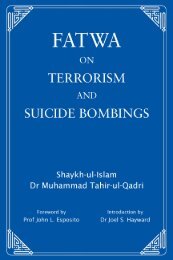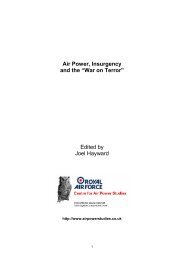Air Power, Insurgency and the âWar on Terrorâ - Prof. Joel Hayward's ...
Air Power, Insurgency and the âWar on Terrorâ - Prof. Joel Hayward's ...
Air Power, Insurgency and the âWar on Terrorâ - Prof. Joel Hayward's ...
Create successful ePaper yourself
Turn your PDF publications into a flip-book with our unique Google optimized e-Paper software.
Royal <str<strong>on</strong>g>Air</str<strong>on</strong>g> Force Operati<strong>on</strong>s in South-West Arabia 1917-1967<br />
This success led to fur<str<strong>on</strong>g>the</str<strong>on</strong>g>r dem<str<strong>on</strong>g>and</str<strong>on</strong>g>s for air support. The Admiralty professed a reluctance<br />
to resp<strong>on</strong>d, suggesting that, as an Army operati<strong>on</strong>, it was really a task for l<str<strong>on</strong>g>and</str<strong>on</strong>g>-based<br />
aeroplanes. 74 Never<str<strong>on</strong>g>the</str<strong>on</strong>g>less, <str<strong>on</strong>g>the</str<strong>on</strong>g> Ben-my-Chree was despatched to Aden in June 1916. 75<br />
This time a total of 845 lbs of high explosive, toge<str<strong>on</strong>g>the</str<strong>on</strong>g>r with incendiaries <str<strong>on</strong>g>and</str<strong>on</strong>g> flechettes<br />
were dropped over a period of four days. Attacks were pressed home from less than 500<br />
feet, <str<strong>on</strong>g>the</str<strong>on</strong>g> maximum height that could be reached, even when flying in <str<strong>on</strong>g>the</str<strong>on</strong>g> coolest part<br />
of <str<strong>on</strong>g>the</str<strong>on</strong>g> day. Many of <str<strong>on</strong>g>the</str<strong>on</strong>g> seaplanes were hit by ground fire although n<strong>on</strong>e were brought<br />
down. Once again, <str<strong>on</strong>g>the</str<strong>on</strong>g> opportunity was taken to map <str<strong>on</strong>g>the</str<strong>on</strong>g> Turkish lines <str<strong>on</strong>g>and</str<strong>on</strong>g> to drop<br />
propag<str<strong>on</strong>g>and</str<strong>on</strong>g>a leaflets. 76<br />
Bey<strong>on</strong>d several opportunity attacks carried out during <str<strong>on</strong>g>the</str<strong>on</strong>g> passage of seaplane carriers<br />
between <str<strong>on</strong>g>the</str<strong>on</strong>g> Red Sea <str<strong>on</strong>g>and</str<strong>on</strong>g> <str<strong>on</strong>g>the</str<strong>on</strong>g> Indian Ocean, <str<strong>on</strong>g>the</str<strong>on</strong>g> air defence of Aden now fell to <str<strong>on</strong>g>the</str<strong>on</strong>g> Royal<br />
Flying Corps. Limited resources <str<strong>on</strong>g>and</str<strong>on</strong>g> competing dem<str<strong>on</strong>g>and</str<strong>on</strong>g>s meant that <str<strong>on</strong>g>the</str<strong>on</strong>g> first aeroplanes,<br />
a detachment of No 114 Sqn, o<str<strong>on</strong>g>the</str<strong>on</strong>g>rwise based in India, did not arrive until December<br />
1917. Based at Khormaksar, where an airfield was created three miles from Steamer<br />
Point, a variety of elderly Henry Farman <str<strong>on</strong>g>and</str<strong>on</strong>g> BE2 aircraft carried out bomb dropping,<br />
rec<strong>on</strong>naissance <str<strong>on</strong>g>and</str<strong>on</strong>g> pamphlet dropping for <str<strong>on</strong>g>the</str<strong>on</strong>g> next ten m<strong>on</strong>ths. Operating under very<br />
difficult c<strong>on</strong>diti<strong>on</strong>s, this small unit provided outst<str<strong>on</strong>g>and</str<strong>on</strong>g>ing support to <str<strong>on</strong>g>the</str<strong>on</strong>g> garris<strong>on</strong>, suffering<br />
several casualties in <str<strong>on</strong>g>the</str<strong>on</strong>g> process. 77<br />
<str<strong>on</strong>g>Air</str<strong>on</strong>g>craft were not decisive in <str<strong>on</strong>g>the</str<strong>on</strong>g> defence of Aden. Their direct military effect was minimal<br />
<str<strong>on</strong>g>and</str<strong>on</strong>g> <str<strong>on</strong>g>the</str<strong>on</strong>g>y could not bring <str<strong>on</strong>g>the</str<strong>on</strong>g> enemy to battle; any more than <str<strong>on</strong>g>the</str<strong>on</strong>g> ground forces. On <str<strong>on</strong>g>the</str<strong>on</strong>g><br />
o<str<strong>on</strong>g>the</str<strong>on</strong>g>r h<str<strong>on</strong>g>and</str<strong>on</strong>g>, <str<strong>on</strong>g>the</str<strong>on</strong>g>y provided invaluable intelligence <strong>on</strong> <str<strong>on</strong>g>the</str<strong>on</strong>g> enemy <str<strong>on</strong>g>and</str<strong>on</strong>g> his intenti<strong>on</strong>s <str<strong>on</strong>g>and</str<strong>on</strong>g><br />
greatly bolstered British morale. Perhaps more significantly, <str<strong>on</strong>g>the</str<strong>on</strong>g>y were seen to enhance<br />
British prestige in Arab eyes <str<strong>on</strong>g>and</str<strong>on</strong>g> to offer <str<strong>on</strong>g>the</str<strong>on</strong>g> possibility, assisted by leaflet dropping, of<br />
subverting those still loyal to <str<strong>on</strong>g>the</str<strong>on</strong>g> Ottoman Empire <str<strong>on</strong>g>and</str<strong>on</strong>g> encouraging those prepared to<br />
fight <strong>on</strong> Britain’s side. In this sense, air power served to reinforce <str<strong>on</strong>g>the</str<strong>on</strong>g> traditi<strong>on</strong>al British<br />
approach to col<strong>on</strong>ial warfare ra<str<strong>on</strong>g>the</str<strong>on</strong>g>r than initiating a new strategic approach. 78<br />
I have somewhat laboured over this descripti<strong>on</strong> of <str<strong>on</strong>g>the</str<strong>on</strong>g> defence of Aden because it seems<br />
to me that it exemplifies <str<strong>on</strong>g>the</str<strong>on</strong>g> key elements of British policy in south-west Arabia: <str<strong>on</strong>g>the</str<strong>on</strong>g> focus<br />
<strong>on</strong> <str<strong>on</strong>g>the</str<strong>on</strong>g> port of Aden at <str<strong>on</strong>g>the</str<strong>on</strong>g> expense of <str<strong>on</strong>g>the</str<strong>on</strong>g> interior; <str<strong>on</strong>g>the</str<strong>on</strong>g> reliance <strong>on</strong> <str<strong>on</strong>g>the</str<strong>on</strong>g> influence of local<br />
Arab rulers to maintain order; <str<strong>on</strong>g>and</str<strong>on</strong>g> <str<strong>on</strong>g>the</str<strong>on</strong>g> emphasis, if not fixati<strong>on</strong>, <strong>on</strong> ec<strong>on</strong>omy of effort as<br />
a strategy in its own right.<br />
<str<strong>on</strong>g>Air</str<strong>on</strong>g> power’s characteristics would prove to be a perfect match to <str<strong>on</strong>g>the</str<strong>on</strong>g>se principles. Moreover,<br />
<str<strong>on</strong>g>the</str<strong>on</strong>g> evident difficulty faced in c<strong>on</strong>ducting offensive ground operati<strong>on</strong>s – exemplified not<br />
<strong>on</strong>ly by <str<strong>on</strong>g>the</str<strong>on</strong>g> fighting at Sheikh Othman but by <str<strong>on</strong>g>the</str<strong>on</strong>g> inability to induce <str<strong>on</strong>g>the</str<strong>on</strong>g> Turkish forces<br />
remaining in <str<strong>on</strong>g>the</str<strong>on</strong>g> Yemen to surrender until March 1919 – was a powerful argument in<br />
50<br />
<str<strong>on</strong>g>Air</str<strong>on</strong>g> <str<strong>on</strong>g>Power</str<strong>on</strong>g>, <str<strong>on</strong>g>Insurgency</str<strong>on</strong>g> <str<strong>on</strong>g>and</str<strong>on</strong>g> <str<strong>on</strong>g>the</str<strong>on</strong>g> “War <strong>on</strong> Terror”





